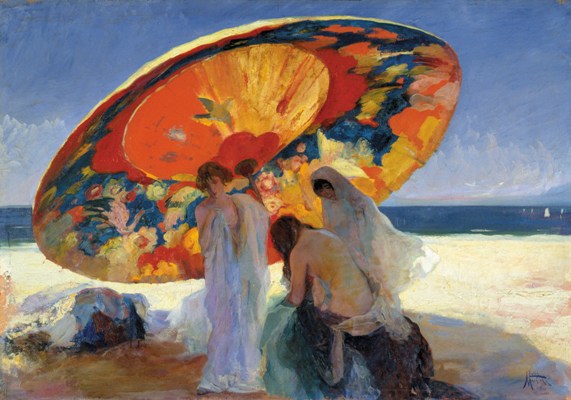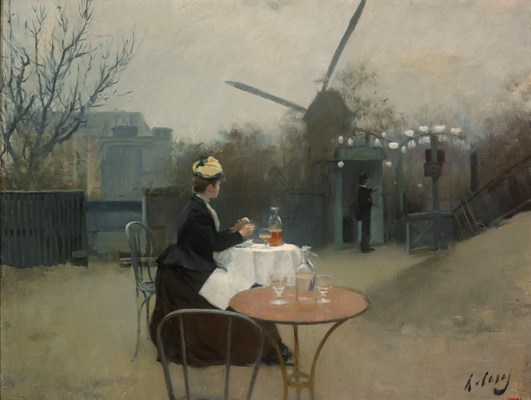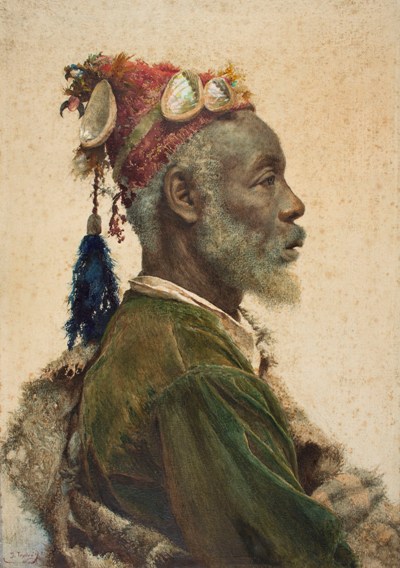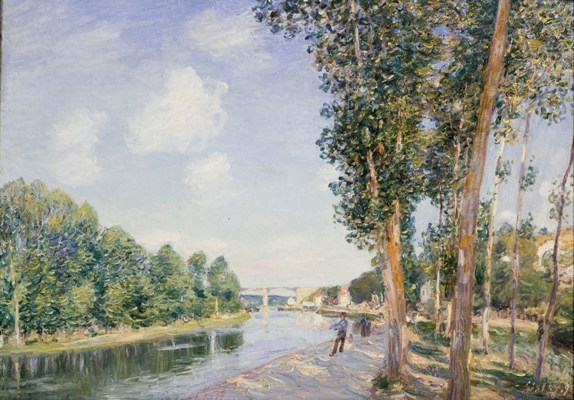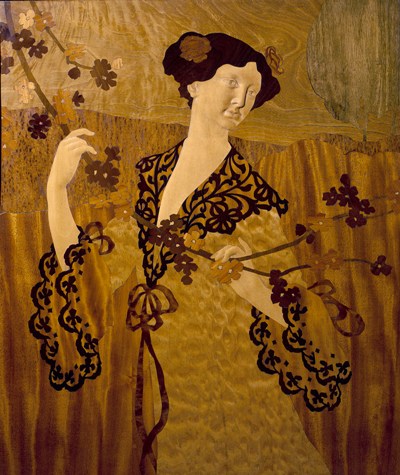With this post we start the Curiosities of the collection articles, that we will publish on a regular basis. This first one is dedicated to our Modern Art Collection.
Did you know that this painting is one of the most plagiarised works, and of great media interest, of Catalan art?
This painting that represents some figures on the beach under a large umbrella, of intense and bright chromaticism and of Japanese influence, enjoyed a major popularity. To the extent that it was the object of a large amount of plagiarism, and figured in posters or even Japanese fans. Lluís Masriera held an exhibition in London of the replicas of this painting (with highly successful sales) and, at a later stage, encouraged by the popularity achieved, he wrote the comedy entitled Sota l’ombrel·la (Under the umbrella) the model of the scenography of which had been included in the exhibition of the Decorative Arts of Paris in 1925.
On the eve of the Civil War, friends and admirers of Lluís Masriera made a donation of this painting to the museum, acquired by public subscription.
Mariàngels Fondevila
Did you know that Ramon Casas was not particularly satisfied with his well-known painting Plein air?
Produced during his stay in Montmartre in the company of Santiago Rusiñol, in which both artists painted a major part of the best works of their respective productions, Casas decided to send this canvas to the General Exposition of Fine Arts held in Barcelona in 1891, instead of holding it back for some of the Parisian artistic manifestations. As Casas himself explains in a letter which, from Paris, he sent to his sister Elisa, “that little painting of the windmill [was] one of the worst I have done this winter, even though it turns out to be rather sellable, and that’s why I sent it there”.
Regardless of the fact that his self-criticism was right, this was something that highlighted the little interest that Casas had at that time for the artistic environment of his city, in which a very conservative taste prevailed.
Cristina Mendoza
Did you know that the museum conserves an important number of orientalist productions?
The exhibition of Josep Tapiró, a painter who lived for many years in Tangiers, constitutes a magnificent opportunity to remember the orientalist echoes of the Cabinet of Drawings and Prints.
Orientalism is an artistic genre of the 19th century, which historically coincided with the process of colonialist expansion of the European states, characterized by the representation of an exotic and escapist imagery. Among the artists who cultivated these motifs present in the collection, it is worth mentioning Marià Fortuny as one of the most relevant authors. Works such as African beach, View of Tetuan or The Prayer, recently acquired, reveal the high level of quality of the artist and the wealth of a collection that is complemented by the work of other less known painters such as, for example, the Italian Giuseppe Signorini, of whom the Museu Nacional conserves two drawings.
Francesc Quílez
Do you know how much A Bend in the Loing cost in 1917?
In 1916, a group of personalities from the world of art and culture asked to do an exhibition of French artists in Barcelona that, in those moments, were unable to be exhibited in the famous Halls of Paris, which had been closed down due to the First World War. The exhibition was inaugurated on 23rd April 1917 in the Palau de Belles Arts. There were almost 1,500 works and artists as notable as, for example, Manet, Morisot, Degas, Pisarro, Toulouse-Lautrec, Rodin and Gauguin. A landscape by the French impressionist artist Alfred Sisley who participated, was acquired by the City Council of Barcelona for 15,000 Francs, 11,280 pesetas of that time. A substantial amount for the period!
Teresa Guasch
Did you know that the contempt towards modernism favoured the fact that, paradoxically, the museum would incorporate a very important collection of decorative arts?
A major part of this collection would be incorporated from the decade of the 1960s onwards, on the occasion of some exhibitions about Modernism at a time when this movement was strongly underrated. From that moment on significant collections were introduced, among which it is worth highlighting the furniture, the rugs, the lights and the marquetry of Gaspar Homar which came from the main floor of the Lleó Morera House, in the street of passeig de Gràcia.
On the occasion of this new presentation of the modern art collection, the modernist decorative arts collections have been increased in a very noticeable way.
Mariàngels Fondevila
Related links
New display of Modern Art, Museu Nacional d’Art de Catalunya
The interiors of ‘Modernism’ in Barcelona, Virtual tour of the Museu Nacional d’Art de Catalunya

